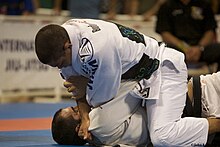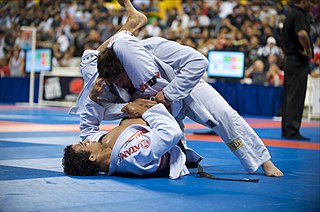
Brazilian Jiu-Jitsu is a martial art and combat sport based on ground fighting (ne-waza) and submission holds. BJJ focuses on the skill of taking an opponent to the ground, controlling one's opponent, gaining a dominant position, and using a number of techniques to force them into submission via joint locks or chokeholds.

The guard is a ground grappling position in which one combatant has their back to the ground while attempting to control the other combatant using their legs. In pure grappling combat sports, the guard is considered an advantageous position, because the bottom combatant can attack with various joint locks and chokeholds, while the top combatant's priority is the transition into a more dominant position, a process known as passing the guard. In the sport of mixed martial arts, as well as hand-to-hand combat in general, it is possible to effectively strike from the top in the guard, even though the bottom combatant exerts some control. There are various types of guard, with their own advantages and disadvantages.
A triangle choke, or sankaku-jime (三角絞) in judo, is a type of figure-four chokehold that encircles the opponent's neck and one arm with the legs in a configuration similar to the shape of a triangle. Applying pressure using both legs and the opponent's own shoulder, the technique is a type of lateral vascular restraint that constricts the blood flow from the carotid arteries to the brain, potentially resulting in loss of consciousness in seconds when applied correctly. Recent studies have shown that the triangle choke takes an average of 9.5 seconds to render an opponent unconscious from the moment it is properly applied.
An armlock in grappling is a single or double joint lock that hyperextends, hyperflexes or hyperrotates the elbow joint or shoulder joint. An armlock that hyper-extends the arm is known as an armbar, and it includes the traditional armbar, pressing their elbow into your thigh, and the triangle armbar, like a triangle choke, but you press their elbow into your thigh. An armlock that hyper-rotates the arm is known as an armcoil, and includes the americana, kimura, and omaplata. Depending on the joint flexibility of a person, armcoils can either hyper-rotate only the shoulder joint, only the elbow joint, or both the elbow joint and shoulder joint. Generally, armcoils hurt more than armbars, as they attack several joints at the bone and muscle.
Back mount, or rear mount, is a dominant grappling position where the practitioner is on his opponent's back in such a way that he has control of his opponent. Ideally, the opponent will be recumbent (prone), while the practitioner centers his weight atop the opponent, either in a seated or recumbent posture. Many consider back mount to be a very dominant, perhaps even the most advantageous position in grappling. This is due to the practitioner being able to attack with strikes and submissions with the opponent having a severely limited ability to see incoming attacks and defend against them.

In grappling, side control is a dominant ground grappling position where the top combatant is lying perpendicularly over the face-up bottom combatant in such a way that the legs are free and he or she exerts no control over the combatant on the bottom. The top combatant is referred to as having side control, and is in a stable position, with the other combatant pinned beneath them. From there the top combatant can proceed with elbows, knees, various submissions, or transition into a mounted position. It is high priority for the bottom combatant to sweep the top combatant or otherwise escape the position, for instance by entangling the opponent's free legs and trying to obtain the half guard or guard.

A grappling hold, commonly referred to simply as a hold that in Japanese is referred to as katame-waza, is any specific grappling, wrestling, judo, or other martial art grip that is applied to an opponent. Grappling holds are used principally to control the opponent and to advance in points or positioning. The holds may be categorized by their function, such as clinching, pinning, or submission, while others can be classified by their anatomical effect: chokehold, headlock, joint-lock, or compression lock. Multiple categories may be appropriate for some of these holds.

In combat sports, the north–south position is a ground grappling position where one combatant is supine, with the other combatant invertedly lying prone on top, normally with their head over the bottom combatant's chest. The north–south position is a dominant position, where the top combatant can apply effective strikes such as knee strikes to the head, or easily transition into various grappling holds or more dominant positions. Transitioning into side control can be done by first switching into a particular hold known as ushiro-kesa-gatame (後袈裟固) or reverse scarf hold, where the chest points to the side, and the opponent's arm is controlled similarly to kesa-gatame. The north–south choke is employed exclusively from this position.

Half guard is a ground grappling position where one combatant is lying on the other, with the bottom combatant having one leg entangled. Sometimes the bottom combatant is said to be in half guard, while the top combatant is in a half mount. In wrestling and catch wrestling half mount is called Turk ride. The half guard is the position that is in between a full guard and side control or full mount. The combatant on top will try to untangle the leg and pass to obtain side control or mount, while the bottom combatant will try to transition into a full guard or alternatively attempt a sweep or submission. The half guard may favour the combatant on top or the guard player, depending on the many details of the position such as body positioning and grips.

Knee-on-stomach, or knee-on-belly, knee-on-chest, knee-ride, knee mount, is a dominant ground grappling position where the top combatant places a knee on the bottom combatant's torso, and usually extends the other leg to the side for balance. This position is typically obtained from side control, simply by rising up slightly and putting a knee on the opponent's stomach or chest.

Kesa-Gatame (袈裟固) is one of the seven mat holds, Osaekomi-waza, of Kodokan Judo. In grappling terms, it is categorized as a side control hold. It is commonly referred to as scarfhold in English due to erroneous translation from Japanese; the 'scarf' in scarfhold is in reference not to a western neck scarf but instead to a Buddhist Monk's sash worn from the left shoulder towards the right hip which was formerly known as 'kesa'. It is also known in wrestling as the head and arm ride.

Kata-Gatame (肩固) is one of the seven mat holds, Osaekomi-waza, of Kodokan Judo. It is also one of the 25 techniques of Danzan Ryu's constriction arts, Shimete, list. In grappling terms, it is categorized as a side control hold. Primarily used as a hold down in Judo, it is mostly used as a choke in Jiu-Jitsu and mixed martial arts. WWE wrestler Braun Strowman and former Impact Wrestling Superstar, Samuel Shaw use this move as their finishing maneuver.
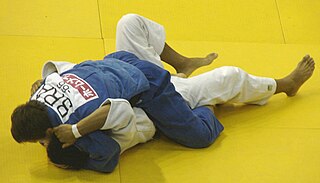
Tate-Shiho-Gatame (縦四方固) is one of the seven mat holds, Osaekomi-waza, of Kodokan Judo. In grappling terms, it is categorized as a mounted position.

Kuzure-Kami-Shiho-Gatame (崩上四方固) is one of the seven mat holds, Osaekomi-waza, of Kodokan Judo, a variation of Kami shiho gatame. In grappling terms, it is categorized as a north-south hold.
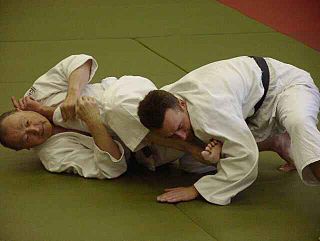
Ude-Hishigi-Hiza-Gatame (腕挫膝固) is one of the official 29 grappling techniques of Kodokan Judo. It is one of the nine joint techniques of the Kansetsu-waza list, one of the three grappling lists in Judo's Katame-waza enumerating 29 grappling techniques.
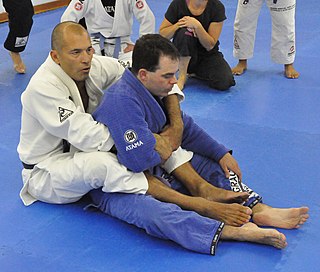
Hooks is a term in grappling martial arts that generally refers to the use of careful positioning of a practitioner’s feet and legs to control and manipulate the movement or position of their opponent. One of the most common uses of hooks is in the back control position to prevent escape. However, a practitioner may alternatively use hooks to defend, sweep, or attack their opponent.

The North–south choke is a choking technique in grappling, employed exclusively from the north–south position, and classified as an air choke-hold. It closely resembles one of the seven mat holds, or osaekomi-waza, of Kodokan Judo, Kuzure kami shiho gatame. This technique is comparable in procedure to the D’arce choke, except that the practitioner is 180 degrees opposite their opponent.

